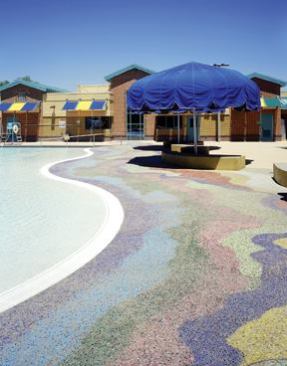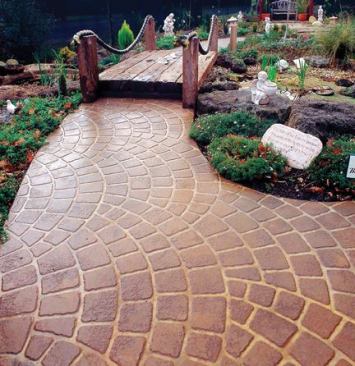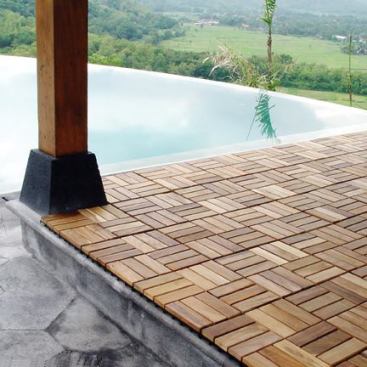Pool builders are not doing their customers, or their projects, justice by settling for a run-of-the-mill deck. Specialty decking is a great way to upsell a pool contract — and generate more income if you handle the job in-house.
“Pool builders leave a lot of money on the table by not wanting anything to do with pool decks,” says Art Pinto, president of Decosup Inc. in Miami. “We’ve invited a lot of pool builders to our [concrete decking] seminars. Some catch on; others don’t want to do it. But when the economy is down, you can offer to do the deck and get a lot more out of the job than just doing the pool.”
Here are three specialty deck techniques that can help grow your bottom line.
Lithocrete
Lithocrete goes back about a quarter of a century, and still is the patented process of Shaw & Sons, a Costa Mesa, Calif.-based concrete construction firm. If you want to use the process, you must get training from a certified licensee and licensed instructor.
San Diego concrete contractor T.B. Penick & Sons Inc. is the master licensee for Lithocrete and has trained an increasing number of pool builders on the technique in recent years. Training is normally a four-day process and costs $16,000. Its advocates say it is an investment that pays off in the ability to create unique and beautiful decking.
The classes are necessary because the process is rather complicated, says Christina Palpal-Latoc, business development manager at T.B. Penick & Sons.
“If you don’t put the sand base in, you’ll have failure,” she says. “If you don’t have the right additive mixtures, you’ll have failure. If you’re stacking too many materials, you’ll have failure. If you’re not using the right retarding agent, you won’t get a perfect consistency, which, to some people, is failure. So the proper training is important.”
Lithocrete can employ just about any kind of aggregate imaginable, including gravel, sand and crushed rock commonly found in standard concrete deck installations. But it also can incorporate more decorative materials such as granite, quartz, marble, seashells and crushed recycled glass.
The variety of aggregate choices is possible because Lithocrete isn’t merely a topping to the base concrete deck, but is part of the structural concrete itself. The result is increased durability that makes a job look as good after 10 years as it did when first installed, according to the company.
“Wash a regular concrete surface with aggregate [and] you’ll see wand marks, and the surface becomes rough,” says Frank Klemaske, executive vice president of T.B. Penick & Sons. “You don’t get that with Lithocrete.
“You can build an awesome pool deck, something really beautiful,” he asserts. “But the real beauty is that you have a surface that is just about indestructible.”
Lithocrete is typically applied over a 2-inch sand base, hand seeded, or shoveled out and spread with a power trowel. It is topped with a nonslip sealant that blocks salt stains and makes it safe near water. The result is a smooth surface, not a rough texture as with most aggregate applications.
Such levels of aesthetics, creative options and durability don’t come cheap, however. Putting down a crushed granite Lithocrete application runs about $20 per square foot; $25 per square foot for incorporating recycled glass. For that reason, Lithocrete traditionally has been used in big-budget commercial applications such as public parks, shopping malls or corporate offices. But the technique is slowly growing as a residential application.
Clients on tight budgets might be sold on Lithocrete if it’s used to accent areas around the pool or to work in tandem with stamped or stained concrete. But upscale customers can afford a deck completely surfaced with Lithocrete.
“It’s amazing what people are spending on decks now,” says Jim Dill, division manager at Deck-O-Seal in Weatherford, Texas. “Some people are spending $1 million or more on their pool projects — and it’s not all for the swimming pool. A good bit of that is for the deck. It’s funny because when you talk about award-winning pools, more often than not, you’re talking about the deck.”
Stencils
The technique of stenciling concrete has been around for decades, but it has taken off in pool designs in the past few years. One reason: It’s an economical way to impart an artistic touch and set a project apart, often for just a few extra dollars per square foot.
“Anybody can afford stenciling,” Decosup’s Pinto says. “Most people who get stencil work done are middle class. You don’t have to be rich. A few extra dollars won’t break the construction budget and leave you broke.”
Despite the sophisticated look, stenciling is among the easiest specialty techniques to master if a crew knows the basics of concrete installation. The best way to learn is to attend training seminars from the companies that sell stenciling products. Training sessions range from a few hundred dollars per class to more than $1,000, with the only limit being how much expertise you want to obtain.
“We tell guys, ‘Come to our seminar, and go to another company’s seminar,’” Pinto says. “‘That way you’ll learn everything you can, and, hopefully, you’ll come back and get your products from us.’”
With stenciling seminars and some practice under your belt, you’re ready to apply patterns for clients.
Stenciling often is done on new decks, where a trained technician can trowel on the stencil pattern while the cement is still wet. But it works on existing decks for pool remodels, too. Simply pick out a stencil — anything from basic brick and stone patterns to designs copyrighted by stencil artists — and apply an overlay mix of color.
“You can do anything with stencils,” Dill says. “I’ve been to a pool where the deck is concrete, but it looks like wood planks. I’ve seen concrete that looks like brick paving or fancy stone work. It’s like a painting. There’s not a lot you can’t do anymore with concrete stenciling.”
Stencils also can help make pool decks safer by adding texture to the surface. Mixing sand with a concrete sealer may leave uneven areas of grit, heavy in some places and thin in others. If you stencil in a ground-polypropylene nonslip additive — which comes in many varieties and is commonly called “grip” — you’ve created a safer surface for those who use the pool.
“Sand eventually wears out, and can leave a pattern that people will notice,” Pinto says. “The [polypropylene] additive will give you better footing, even when wet, and looks better, too.”
Stenciling is appropriate for a variety of climates in North America, but is easier to manage in warmer areas. It’s not because an intense freeze/thaw cycle will stress the stenciling work, but because nature will begin to damage the concrete base. To lessen the wear and tear, experts recommend mixing more air in the concrete for colder climates, so the deck will take the seasonal expansions and contractions in stride.
Teak
Called the “king of all woods,” teak is among the most expensive materials to use for decking, costing $25 per square foot and up. Yet it’s also the simplest to install.
If a client chooses long planks of teak, installation is not much more complicated than putting in a pressure-treated wood deck using materials from a home-improvement store. Teak tiles are even simpler.
While virtually no special training is required for pool builders taking on this work, some basic installation principles should be followed to ensure that clients are satisfied.
Teak tiles, which can be custom milled for a job’s specific needs, are best laid on top of a bed of sand. Often the tiles are linked with a series of connecting joints already attached to their sides and bottoms, or they come with grooves in the sides where plastic or metal connectors will join them together.
Teak wood is suitable for any climate. But because of the product’s organic nature, it is best to let the tiles adapt to local weather conditions before installation.
“We recommend letting them sit in the environment for at least two weeks so they can adjust,” says Marion Hamilton, vice president of Dallas-based East Teak Fine Hardwoods Inc., whose company recently installed teak tiles around several pools at Hilton
Hotels in Southern California. “If you can wait longer than that, it’s even better.”
If the teak is left untreated, it will eventually weather into a silvery-gray patina.
But some clients think this natural process looks too weathered. In such cases, customers must be informed that keeping the golden wood color requires frequent oiling and sealing — at least annually, and as often as three times a year in extreme climates.
“Personally, I’m lazy, so silver-gray is fine with me,” Hamilton says. “But if you do finish it, the most important thing is to make sure the products you use on the teak are formulated for exotic hardwoods. You could even make that treatment part of your pool service, if you wanted.”
image #1, photo by Ron Shaw / Shaw & Sons
image #2, Stencil Systems Canada Inc.
image #3, Infinita Corp.


